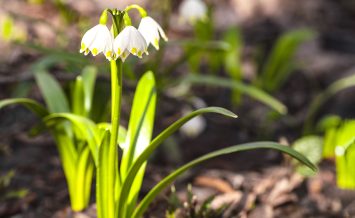How to avoid plant losses, flowering disappointments and container catastrophes
As the colder weather sets in, we offer a 10-point checklist to help your garden survive the worst of winter.
As winter begins to make itself known, you may want to hibernate in front of a roaring fire – but there are some jobs that just won’t wait unless you’re prepared to have to do more work, and spend more money, next year.
So, put on your woollies and your wellies and brave the elements before it’s too late, with these jobs that won’t wait…
1. Protect vulnerable plants

Wrapping permanent plantings with fleece will help protect them over winter
Any plants that aren’t totally hardy will need some protection outdoors. Cover vulnerable plants with cloches or horticultural fleece if harsh frost is forecast and protect newly-planted trees and shrubs over the winter with windbreaks, or wrap a cosy blanket of hessian or horticultural fleece around them.
2. Avoid cracked pots

Don’t let frost crack your pots
If you have terracotta pots that aren’t frost-hardy, clear them out of any plants and compost, wash them and store them under cover in a frost-free place such as a shed.
Protect pots containing permanent plants of borderline hardiness by grouping them together in a sheltered spot and wrapping them with hessian or horticultural fleece.
3. Plant bulbs sooner rather than later

Plant tulips in November
Tulips are best planted at the beginning of November, but try to get all your bulb planting done by then or you may have problems digging planting holes in your borders as the ground hardens up during winter.
4. Watch out for windy weather

Prepare for winter winds by removing dead or decaying branches on established trees. Check the stakes of newly-planted trees are secure and make sure that fences, trellises and other structures which prop up climbing plants are all secure enough to withstand high winds.
5. Get pruning
Once the leaves have fallen from ornamental trees such as acers and sorbus, you can prune them lightly while dormant, to keep their framework neat. Do the same with young trees and shrubs to give them a good framework from the get-go. Many shrubs, however, can be left for pruning in late winter and early spring.
6. Keep weeding
Although the growth of weeds will slow down as the weather gets cooler, they will spring up again next year unless you catch them now, so dig up as many as you can before the ground becomes too hard to work.
7. Look after fish

If you have fish in your pond, don’t let it freeze over
If you have fish in your pond, stop the water from freezing by floating a ball on the surface, or consider installing a pond heater.
8. Move plants
If you want to switch plants around, or just need to lift and divide overgrown clumps, do it now while the ground is still soft enough to work. You’ll be able to fill any gaps leftover from summer, while dividing plants will also give you a chance to do some repeat-planting in your borders, which will create a rhythm in your garden next year.
9. Plant and harvest

Protect young vegetables from frost
There’s still time to plant winter salads such as pak choi in the garden, but make sure you cover crops with fleece to protect them from winter weather.
Harvest vegetables including kale, spinach, turnips, parsnips, winter cabbage and the first Brussels sprouts, but make sure you stake your plants with canes now as they can become quite large and you don’t want the sprouts to touch the ground.
10. Order seeds and plants

When you do come into the warm, flick through the latest seed catalogues and don’t delay ordering to guarantee you get the varieties you want before they run out of stock.
The Press Association
Latest posts by The Press Association (see all)
- 5 new books to read this week - March 26, 2025
- 6 things a physio wishes people over 60 would stop doing - March 25, 2025
- NHS reminder to 7.5m people as Covid-19 jab booking system opens - March 25, 2025
- The truth about cholesterol – what you need to know - March 25, 2025
- Prince William calls Dame Mary Berry a ‘national treasure’ in 90th birthday message - March 24, 2025




















